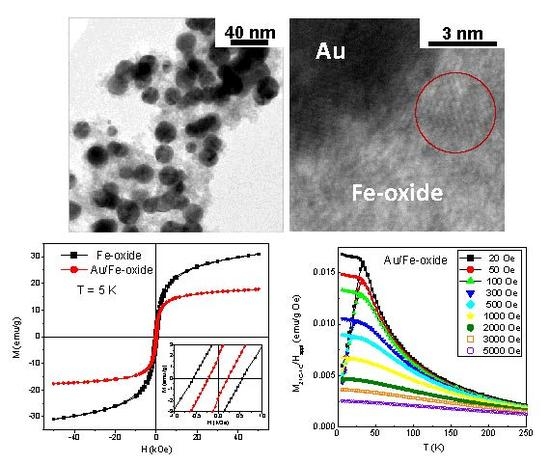Glassy Magnetic Behavior and Correlation Length in Nanogranular Fe-Oxide and Au/Fe-Oxide Samples
Abstract
1. Introduction
2. Experimental
2.1. Synthesis of the Fe-Oxide and Au/Fe-Oxide Nanogranular Samples
2.2. Characterization Techniques
3. Results
3.1. Structural Properties Investigated by TEM
3.2. Magnetic Properties
3.2.1. Hysteresis Loops
3.2.2. Magnetothermal Behavior
4. Discussion
5. Conclusions
Author Contributions
Funding
Conflicts of Interest
References
- Coey, J.M.D. Amorphous magnetic order. J. Appl. Phys. 1978, 49, 1646–1652. [Google Scholar] [CrossRef]
- Mulder, C.A.M.; van Duyneveldt, A.J.; Mydosh, J.A. Susceptibility of the CuMn spin glass: Frequency and field dependences. Phys. Rev. B 1981, 23, 1384–1396. [Google Scholar] [CrossRef]
- Cannella, V.; Mydosh, J.A. Magnetic ordering in gold-iron alloys. Phys. Rev. B 1972, 6, 4220–4237. [Google Scholar] [CrossRef]
- Tholence, J.; Tournier, R. Susceptibility and remanent magnetization of a spin glass. J. Phys. Colloq. 1974, 35, C4-229–C4-235. [Google Scholar] [CrossRef]
- Mydosh, J.A. Spin Glasses: An Experimental Introduction; Taylor and Francis: London, UK, 1993. [Google Scholar]
- Aeppli, G.; Shapiro, S.M.; Birgeneau, R.J.; Chen, H.S. Spin correlations and reentrant spin glass behavior in amorphous Fe-Mn alloys. II. Dynamics. Phys. Rev. B 1984, 29, 2589–2605. [Google Scholar] [CrossRef]
- Del Bianco, L.; Spizzo, F.; Tamisari, M.; Bonetti, E.; Ronconi, F.; Fiorani, D. Changing the magnetism of amorphous FeSiB by mechanical milling. J. Phys. Condens. Matter. 2010, 22, 296010. [Google Scholar] [CrossRef]
- Luo, Q.; Shen, J. Reentrant spin glass ordering in an Fe-based bulk metallic glass. J. Appl. Phys. 2015, 117, 053909. [Google Scholar] [CrossRef]
- Luo, W.; Nagel, S.R.; Rosenbaum, T.F.; Rosensweig, R.E. Dipole interactions with random anisotropy in a frozen ferrofluid. Phys. Rev. Lett. 1991, 67, 2721–2724. [Google Scholar] [CrossRef]
- Dormann, J.L.; Cherkaoui, R.; Spinu, L.; Nogués, M.; Lucari, F.; D’Orazio, F.; Fiorani, D.; Garcia, A.; Tronc, E.; Jolivet, J.P. From pure superparamagnetic regime to glass collective state of magnetic moments in γ-Fe2O3 nanoparticle assemblies. J. Magn. Magn. Mater. 1998, 187, L139–L144. [Google Scholar] [CrossRef]
- Sahoo, S.; Petracic, O.; Binek, C.; Kleemann, W.; Sousa, J.B.; Cardoso, S.; Freitas, P.P. Superspin glass nature of discontinuous Co80Fe20/Al2O3 multilayers. Phys. Rev. B 2002, 65, 134406. [Google Scholar] [CrossRef]
- Jonsson, T.; Svedlindh, P.; Hansen, M.F. Static scaling on an interacting magnetic nanoparticle system. Phys. Rev. Lett. 1998, 81, 3976–3979. [Google Scholar] [CrossRef]
- Alonso, J.; Fdez-Gubieda, M.L.; Barandiarán, J.M.; Svalov, A.; Fernández Barquín, L.; Alba Venero, D.; Orue, I. Crossover from superspin glass to superferromagnet in FexAg100−x nanostructured thin films (20 < x < 50). Phys. Rev. B 2010, 82, 054406. [Google Scholar] [CrossRef]
- Parker, D.; Dupuis, V.; Ladieu, F.; Bouchaud, J.-P.; Dubois, E.; Perzynski, R.; Vincent, E. Spin glass behavior in an interacting γ-Fe2O3 nanoparticle system. Phys. Rev. B 2008, 77, 104428. [Google Scholar] [CrossRef]
- Mørup, S.; Bødker, F.; Hendriksen, P.V.; Linderoth, S. Spin glass-like ordering of the magnetic moments of interacting nanosized maghemite particles. Phys. Rev. B 1995, 52, 287–294. [Google Scholar] [CrossRef]
- De Toro, J.A.; Lee, S.S.; Salazar, D.; Cheong, J.L.; Normile, P.S.; Muñiz, P.; Riveiro, J.M.; Hillenkamp, M.; Tournus, F.; Tamion, A.; et al. A nanoparticle replica of the spin glass state. Appl. Phys. Lett. 2013, 102, 183104. [Google Scholar] [CrossRef]
- Vasilakaki, M.; Margaris, G.; Peddis, D.; Mathieu, R.; Yaacoub, N.; Fiorani, D.; Trohidou, K. Monte Carlo study of the superspin glass behavior of interacting ultrasmall ferrimagnetic nanoparticles. Phys. Rev. B 2018, 97, 094413. [Google Scholar] [CrossRef]
- Mørup, S.; Madsen, M.B.; Franck, J.; Villadsen, J.; Koch, C.J.W. A new interpretation of Mössbauer spectra of microcrystalline goethite: “Super-ferromagnetism” or “super-spin glass” behaviour? J. Magn. Magn. Mater. 1983, 40, 163–174. [Google Scholar] [CrossRef]
- Bedanta, S.; Kleemann, W. Supermagnetism. J. Phys. D: Appl. Phys. 2009, 42, 013001. [Google Scholar] [CrossRef]
- Andersson, M.S. Nanoparticle magnetism: Superspin glasses. J. Nanosci. Nanotechnol. 2019, 19, 4903–4910. [Google Scholar] [CrossRef]
- Coey, J.M.D. Noncollinear spin arrangement in ultrafine ferrimagnetic crystallites. Phys. Rev. Lett. 1971, 27, 1140–1142. [Google Scholar] [CrossRef]
- Aquino, R.; Depeyrot, J.; Sousa, M.H.; Tourinho, F.A.; Dubois, E.; Perzynski, R. Magnetization temperature dependence and freezing of surface spins in magnetic fluids based on ferrite nanoparticles. Phys. Rev. B 2005, 72, 184435. [Google Scholar] [CrossRef]
- Kodama, R.H.; Berkowitz, A.E.; McNiff, E.J.; Foner, S. Surface spin disorder in NiFe2O4 nanoparticles. Phys. Rev. Lett. 1996, 77, 394–397. [Google Scholar] [CrossRef] [PubMed]
- Martinez, B.; Obradors, X.; Balcells, L.; Rouanet, A.; Monty, C. Low temperature surface spin glass transition in γ-Fe2O3 nanoparticles. Phys. Rev. Lett. 1997, 80, 181–184. [Google Scholar] [CrossRef]
- Peddis, D.; Cannas, C.; Piccaluga, G.; Agostinelli, E.; Fiorani, D. Spin glass-like freezing and enhanced magnetization in ultra-small CoFe2O4 nanoparticles. Nanotechnology 2010, 21, 125705. [Google Scholar] [CrossRef]
- Kodama, R.H.; Makhlouf, S.A.; Berkowitz, A.E. Finite size effects in antiferromagnetic NiO nanoparticles. Phys. Rev. Lett. 1997, 79, 1393–1396. [Google Scholar] [CrossRef]
- Winkler, E.; Zysler, R.D.; Vasquez Mansilla, M.; Fiorani, D. Surface anisotropy effects in NiO nanoparticles. Phys. Rev. B 2005, 72, 132409. [Google Scholar] [CrossRef]
- Hernando, A.; Navarro, E.; Multigner, M.; Yavari, A.R.; Fiorani, D.; Rosenberg, M.; Filoti, G.; Caciuffo, R. Boundary spin disorder in nanocrystalline FeRh alloys. Phys. Rev. B 1998, 58, 5181–5184. [Google Scholar] [CrossRef]
- Bonetti, E.; Del Bianco, L.; Fiorani, D.; Rinaldi, D.; Caciuffo, R.; Hernando, A. Disordered magnetism at the grain boundary of pure nanocrystalline Iron. Phys. Rev. Lett. 1999, 83, 2829–2832. [Google Scholar] [CrossRef]
- Sefrioui, Z.; Menéndez, J.L.; Navarro, E.; Cebollada, A.; Briones, F.; Crespo, P.; Hernando, A. Correlation between magnetic and transport properties in nanocrystalline Fe thin films: A grain-boundary magnetic disorder effect. Phys. Rev. B 2001, 64, 224431. [Google Scholar] [CrossRef]
- Del Bianco, L.; Fiorani, D.; Testa, A.M.; Bonetti, E.; Savini, L.; Signoretti, S. Magnetothermal behavior of nanoscale Fe/Fe-oxide granular system. Phys. Rev. B 2002, 66, 174418. [Google Scholar] [CrossRef]
- Del Bianco, L.; Boscherini, F.; Fiorini, A.L.; Tamisari, M.; Spizzo, F.; Vittori Antisari, M.; Piscopiello, E. Exchange bias and structural disorder in the nanogranular Ni/NiO system produced by ball-milling and hydrogen reduction. Phys. Rev. B 2008, 77, 094408. [Google Scholar] [CrossRef]
- Meiklejohnn, W.H.; Bean, C.P. New Magnetic Anisotropy. Phys. Rev. 1957, 102, 1413–1414. [Google Scholar] [CrossRef]
- Nogues, J.; Schuller, I.K. Exchange bias. J. Magn. Magn. Mater. 1999, 192, 203–232. [Google Scholar] [CrossRef]
- Fiorani, D.; Del Bianco, L.; Testa, A.M.; Trohidou, K.N. Glassy dynamics in the exchange bias properties of the iron /iron oxide nanogranular system. Phys. Rev. B 2006, 73, 092403. [Google Scholar] [CrossRef]
- Del Bianco, L.; Spizzo, F.; Tamisari, M.; Castiglioni, A. Coexistence of exchange bias effect and giant magnetoresistance in a Ni/NiO nanogranular sample. J. Appl. Phys. 2011, 110, 043922. [Google Scholar] [CrossRef]
- Del Bianco, L.; Spizzo, F.; Tamisari, M.; Calbucci, M.; Allia, P. Study of the magnetic microstructure of Ni/NiO nanogranular samples above the electric percolation threshold by magnetoresistance measurements. J. Phys. Condens. Matter 2012, 24, 306004. [Google Scholar] [CrossRef]
- Cabreira-Gomes, R.; Silva, F.G.; Aquino, R.; Bonville, P.; Tourinho, F.A.; Perzynski, R.; Depeyrot, J. Exchange bias of MnFe2O4@γFe2O3 and CoFe2O4 @ γFe2O3 core/shell nanoparticles. J. Magn. Magn. Mater. 2014, 368, 409–414. [Google Scholar] [CrossRef]
- He, X.; Xu, Y.; Yao, X.; Zhang, C.; Pu, Y.; Wang, X.; Mao, W.; Du, Y.; Zhong, W. Large exchange bias and enhanced coercivity in strongly-coupled Ni/NiO binary nanoparticles. RSC Adv. 2019, 9, 30195–30206. [Google Scholar] [CrossRef]
- Fernández-García, M.P.; Gorria, P.; Blanco, J.A.; Fuertes, A.B.; Sevilla, M.; Boada, R.; Chaboy, J.; Schmool, D.; Grenèche, J.-M. Microstructure and magnetism of nanoparticles with γ-Fe core surrounded by α-Fe and iron oxide shells. Phys. Rev. B 2010, 81, 094418. [Google Scholar] [CrossRef]
- Prejbeanu, I.L.; Kerekes, M.; Sousa, R.C.; Sibuet, H.; Redon, O.; Dieny, B.; Nozieres, J.P. Thermally assisted MRAM. J. Phys. Condens. Matter 2007, 19, 165218. [Google Scholar] [CrossRef]
- Chappert, C.; Fert, A.; Van Dau, F.N. The emergence of spin electronics in data storage. Nat. Mater. 2007, 6, 813–823. [Google Scholar] [CrossRef] [PubMed]
- Nogués, J.; Sort, J.; Langlais, V.; Skumryev, V.; Suriñach, S.; Muñoz, J.S.; Barò, M.D. Exchange bias in nanostructures. Phys. Rep. 2005, 422, 65–117. [Google Scholar] [CrossRef]
- Takano, K.; Kodama, R.H.; Berkowitz, A.E.; Cao, W.; Thomas, G. Interfacial uncompensated antiferromagnetic spins: Role in unidirectional anisotropy in polycrystalline Ni81Fe19/CoO bilayers. Phys. Rev. Lett. 1997, 79, 1130–1133. [Google Scholar] [CrossRef]
- Baltz, V.; Rodmacq, B.; Zarefy, A.; Lechevallier, L.; Dieny, B. Bimodal distribution of blocking temperature in exchange-biased ferromagnetic/antiferromagnetic bilayers. Phys. Rev. B 2010, 81, 052404. [Google Scholar] [CrossRef]
- Spizzo, F.; Tamisari, M.; Bonfiglioli, E.; Del Bianco, L. Detection of the dynamic magnetic behaviour of the antiferromagnet in exchange-coupled NiFe/IrMn bilayers. J. Phys. Condens. Matter 2013, 25, 386001. [Google Scholar]
- O’Grady, K.; Fernandez-Outon, L.E.; Vallejo-Fernandez, G. A new paradigm for exchange bias in polycrystalline thin films. J. Magn. Magn. Mater. 2010, 322, 883–899. [Google Scholar] [CrossRef]
- Yu, T.; Chen, Q.L.P.; Zhou, L.; Li, H.; Ning, X.; Qiu, C.; He, H. Interfacial spin glass-like state and exchange bias in epitaxial iridate-manganite heterostructure. J. Alloys Compd. 2019, 789, 351–356. [Google Scholar] [CrossRef]
- Gruyters, M. Interacting magnetic defects in a random antiferromagnetic matrix: A spin glass-like model of exchange bias. Phys. Rev. B 2009, 79, 134415. [Google Scholar] [CrossRef]
- Spizzo, F.; Bonfiglioli, E.; Tamisari, M.; Gerardino, A.; Barucca, G.; Notargiacomo, A.; Chinni, F.; Del Bianco, L. Magnetic exchange coupling in IrMn/NiFe nanostructures: From the continuous film to dot arrays. Phys. Rev. B. 2015, 91, 064410. [Google Scholar] [CrossRef]
- Spizzo, F.; Tamisari, M.; Chinni, F.; Bonfiglioli, E.; Gerardino, A.; Barucca, G.; Bisero, D.; Fin, S.; Del Bianco, L. Exchange bias properties of 140nm-sized dipolarly interacting circular dots with ultrafine IrMn and NiFe layers. J. Magn. Magn. Mater. 2016, 400, 242–247. [Google Scholar] [CrossRef]
- Spizzo, F.; Tamisari, M.; Chinni, F.; Bonfiglioli, E.; Del Bianco, L. Interface adjustment and exchange coupling in the IrMn/NiFe system. J. Magn. Magn. Mater. 2017, 421, 234–240. [Google Scholar] [CrossRef]
- Fievet, F.; Lagier, J.; Blin, B.; Beaudoin, B.; Figlarz, M. Homogeneous and heterogeneous nucleations in the polyol process for the preparation of micron and submicron size metal particles. Solid State Ion. 1989, 32/33, 198–205. [Google Scholar] [CrossRef]
- Gatan Microscopy Suite Software Version 3.x. Available online: www.gatan.com/products/tem-analysis/gatan-microscopy-suite-software (accessed on 28 October 2019).
- Trudel, S. Unexpected magnetism in gold nanostructures: Making gold even more attractive. Gold Bull. 2011, 44, 3–13. [Google Scholar] [CrossRef]
- Fiorani, D.; Testa, A.M.; Lucari, F.; D’Orazio, F.; Romero, H. Magnetic properties of maghemite nanoparticle systems: Surface anisotropy and interparticle interaction effects. Phys. B 2002, 320, 122–126. [Google Scholar] [CrossRef]
- Del Bianco, L.; Spizzo, F.; Barucca, G.; Ruggiero, M.R.; Geninatti Crich, S.; Forzan, M.; Sieni, E.; Sgarbossa, P. Mechanism of magnetic heating in Mn-doped magnetite nanoparticles and role of the intertwined structural and magnetic properties. Nanoscale 2019, 11, 10896–10910. [Google Scholar] [CrossRef]
- Fearon, M.; Chantrell, R.W.; Wohlfarth, E.P. A theoretical study of interaction effects on the remanence curves of particulate dispersions. J. Magn. Magn. Mater. 1990, 86, 197–206. [Google Scholar] [CrossRef]
- Morales, M.P.; Serna, C.J.; Bødker, F.; Mørup, S. Spin canting due to structural disorder in maghemite. J. Phys. Condens. Matter 1997, 9, 5461–5467. [Google Scholar] [CrossRef]
- Spizzo, F.; Sgarbossa, P.; Sieni, E.; Semenzato, A.; Dughiero, F.; Forzan, M.; Bertani, R.; Del Bianco, L. Synthesis of ferrofluids made of iron oxide nanoflowers: Interplay between carrier fluid and magnetic properties. Nanomaterials 2017, 7, 373. [Google Scholar] [CrossRef]
- Kim, W.; Suh, C.Y.; Cho, S.W.; Roh, K.M.; Kwon, H.; Song, K.; Shon, I.J. A new method for the identification and quantification of magnetite-maghemite mixture using conventional X-ray diffraction technique. Talanta 2012, 94, 348–352. [Google Scholar] [CrossRef]
- Jonsson, T.; Mattsson, J.; Djurberg, C.; Khan, F.A.; Nordblad, P.; Svedlindh, P. Aging in a magnetic particle system. Phys. Rev. Lett. 1995, 75, 4138–4141. [Google Scholar] [CrossRef]
- Djurberg, C.; Svedlindh, P.; Nordblad, P.; Hansen, M.F.; Bødker, F.; Mørup, S. Dynamics of an interacting particle system: Evidence of critical slowing down. Phys. Rev. Lett. 1997, 79, 5154–5157. [Google Scholar] [CrossRef]
- Del Bianco, L.; Lesci, I.G.; Fracasso, G.; Barucca, G.; Spizzo, F.; Tamisari, M.; Scotti, R.; Ciocca, L. Synthesis of nanogranular Fe3O4/biomimetic hydroxyapatite for potential applications in nanomedicine: Structural and magnetic characterization. Mater. Res. Express 2015, 2, 065002. [Google Scholar] [CrossRef]
- de Almeida, J.R.L.; Thouless, D.J. Stability of the Sherrington-Kirkpatrick solution of a spin glass model. J. Phys. A 1978, 11, 983–990. [Google Scholar] [CrossRef]
- Maletta, H.; Zinn, W. Spin glasses. In Handbook on the Physics and Chemistry of Rare Earths; Gschneidner, K.A., Jr., Eyring, L., Eds.; Elsevier Science Publishers, B.V.: Amsterdam, The Netherlands, 1989; Volume 12, pp. 213–356. [Google Scholar]
- Del Bianco, L.; Spizzo, F.; Tamisari, M.; Laureti, S. Dependence of exchange bias on the field-cooled remanent magnetic state in Ni/NiO nanogranular samples. Solid State Commun. 2011, 151, 351–353. [Google Scholar] [CrossRef]
- Monod, P.; Préjean, J.J.; Tissier, B. Magnetic hysteresis of CuMn in the spin glass state. J. Appl. Phys. 1979, 50, 7324–7329. [Google Scholar] [CrossRef]
- Petracic, O.; Chen, X.; Bedanta, S.; Kleemann, W.; Sahoo, S.; Cardoso, S.; Freitas, P.P. Collective states of interacting ferromagnetic nanoparticles. J. Magn. Magn. Mater. 2006, 300, 192–197. [Google Scholar] [CrossRef]
- Sasaki, M.; Jönsson, P.E.; Takayama, H.; Mamiya, H. Aging and memory effects in superparamagnets and superspin glasses. Phys. Rev. B 2005, 71, 104405. [Google Scholar] [CrossRef]
- Coey, J.M.D. Magnetism and Magnetic Materials; Cambridge University Press: Cambridge, UK, 2010; pp. 161–167. [Google Scholar]
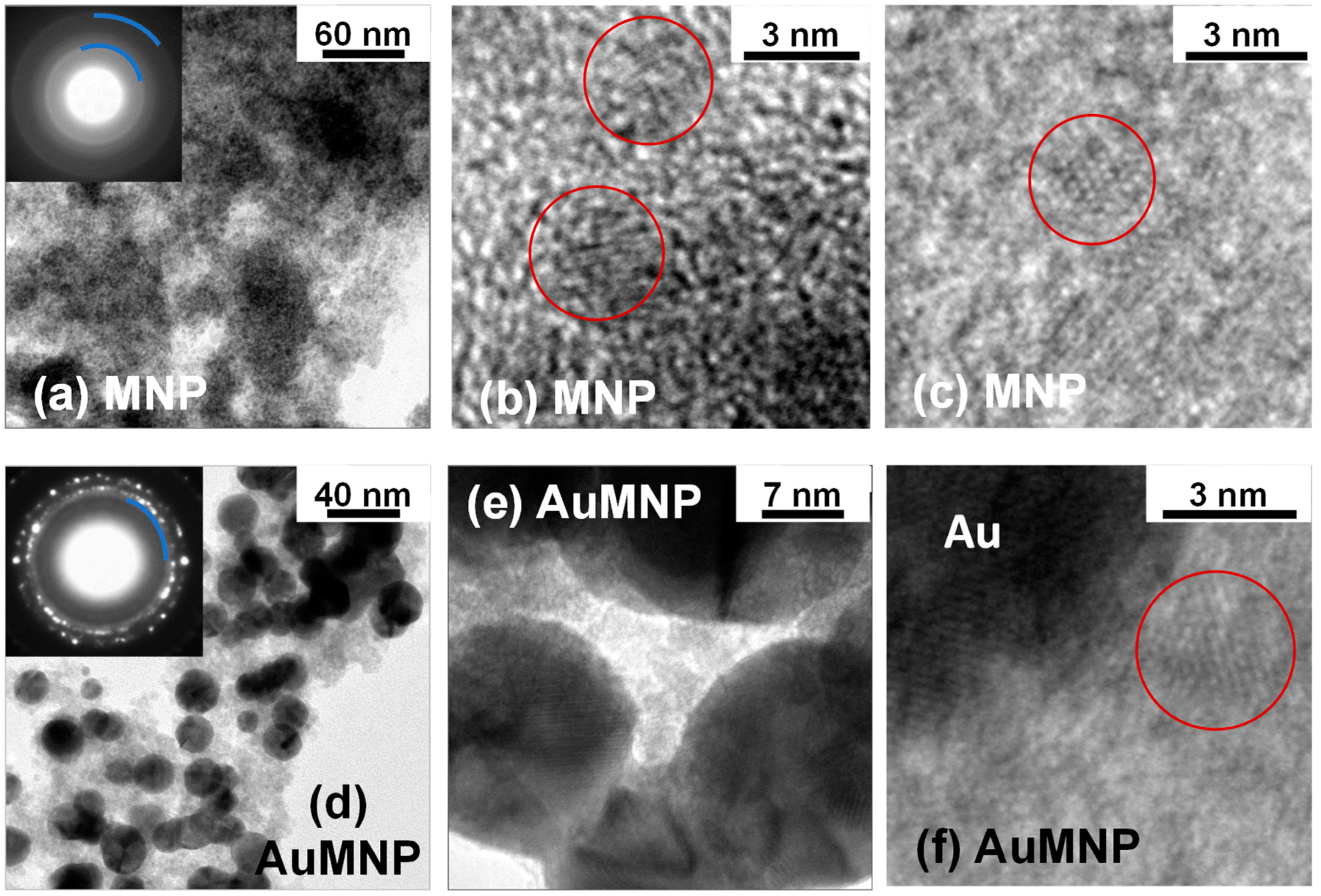
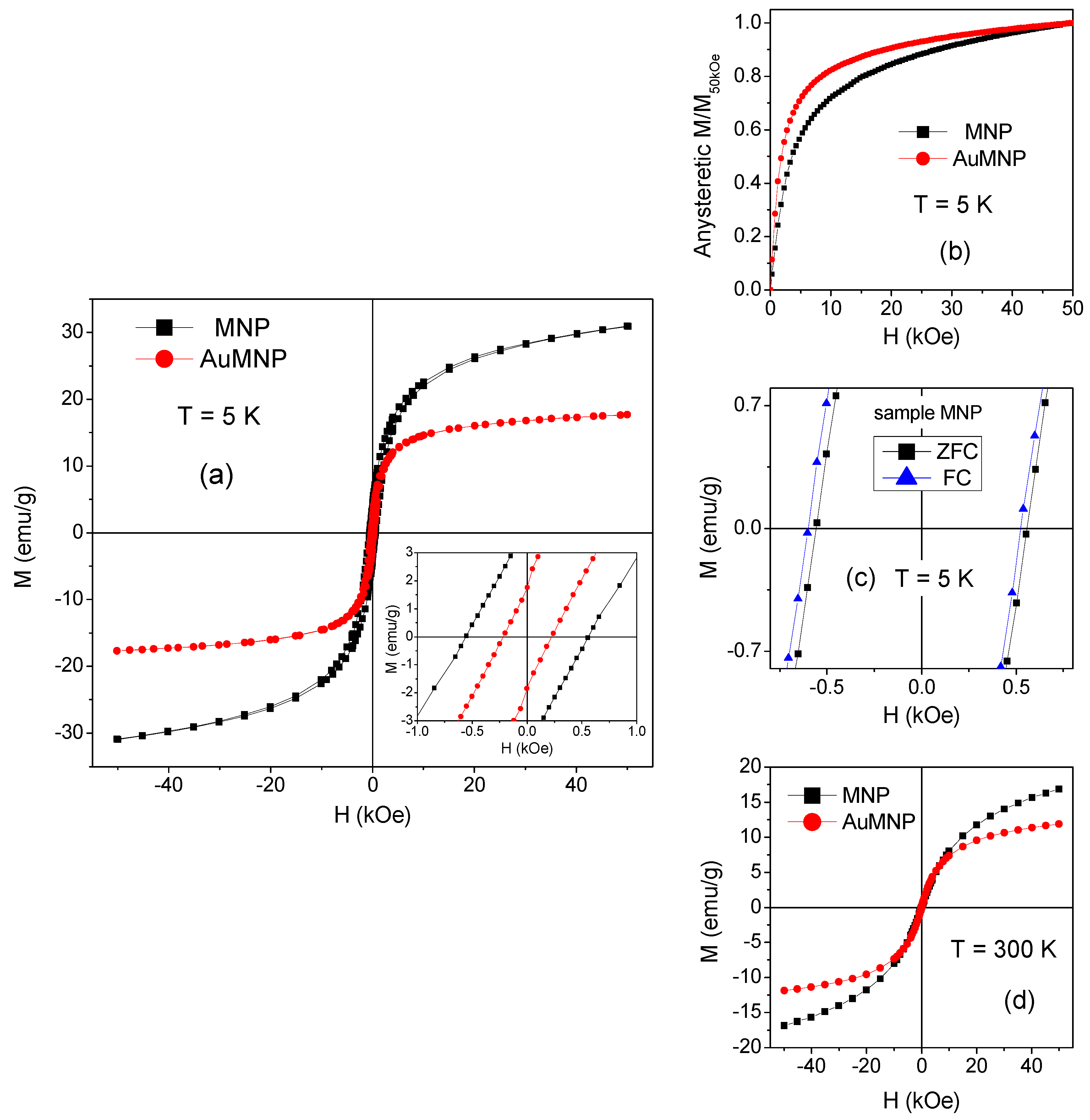
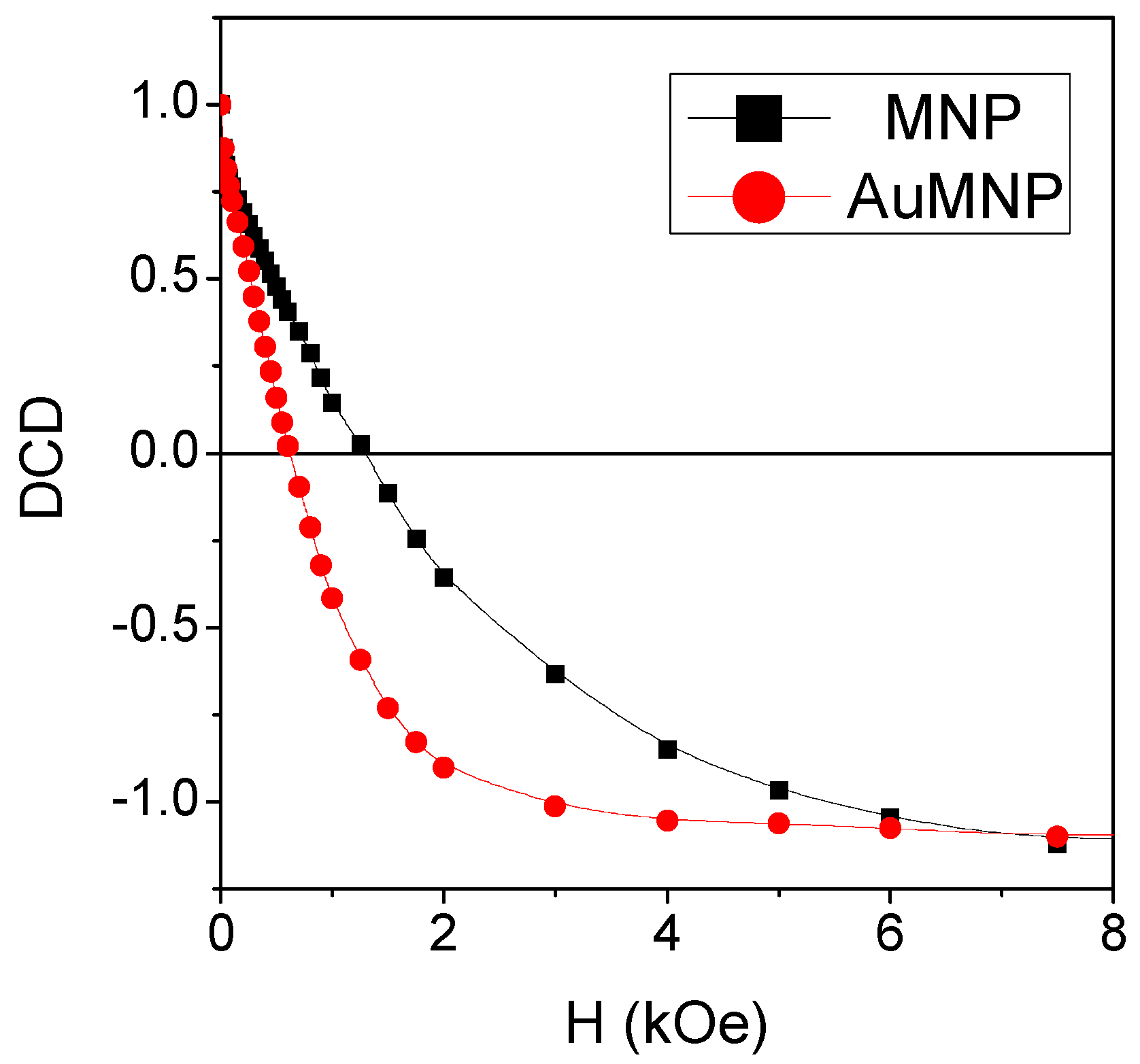
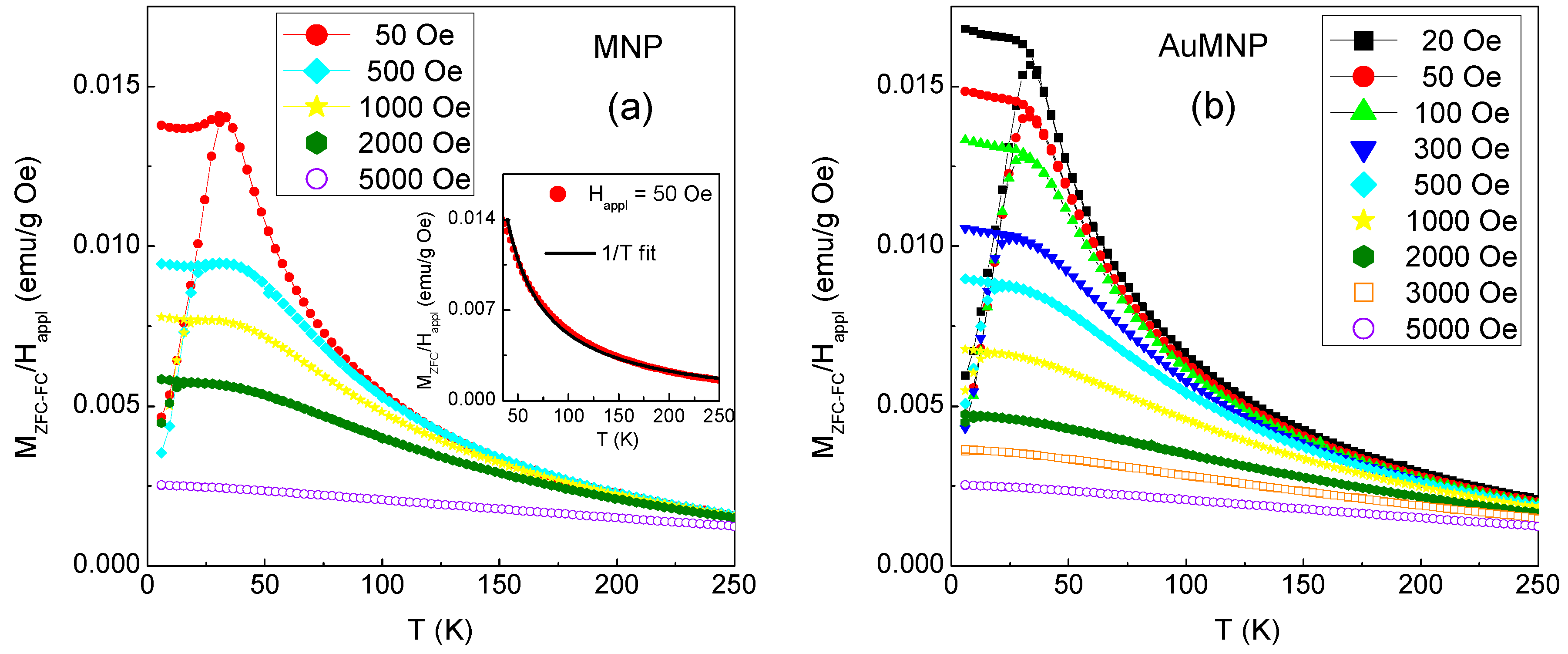
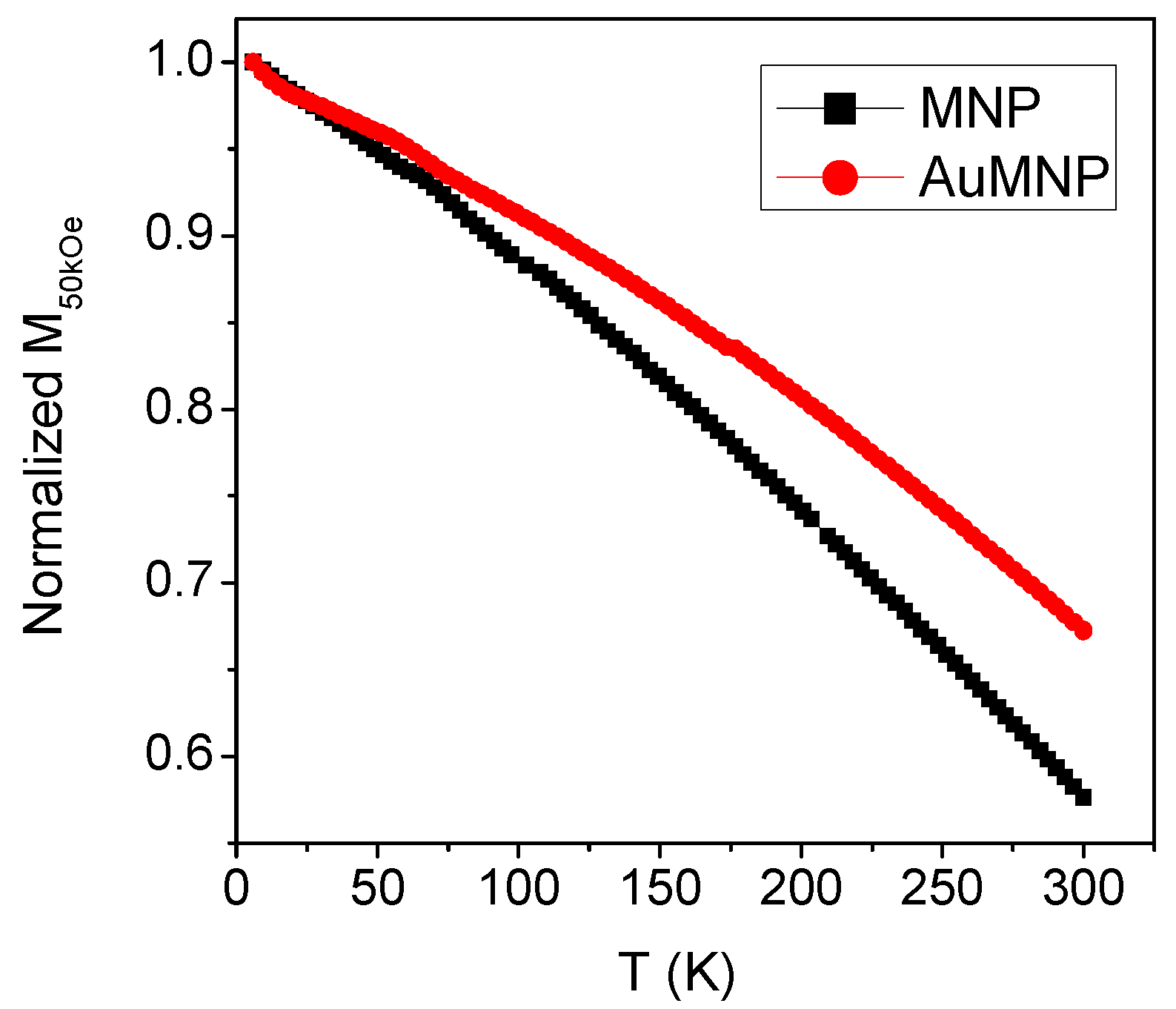
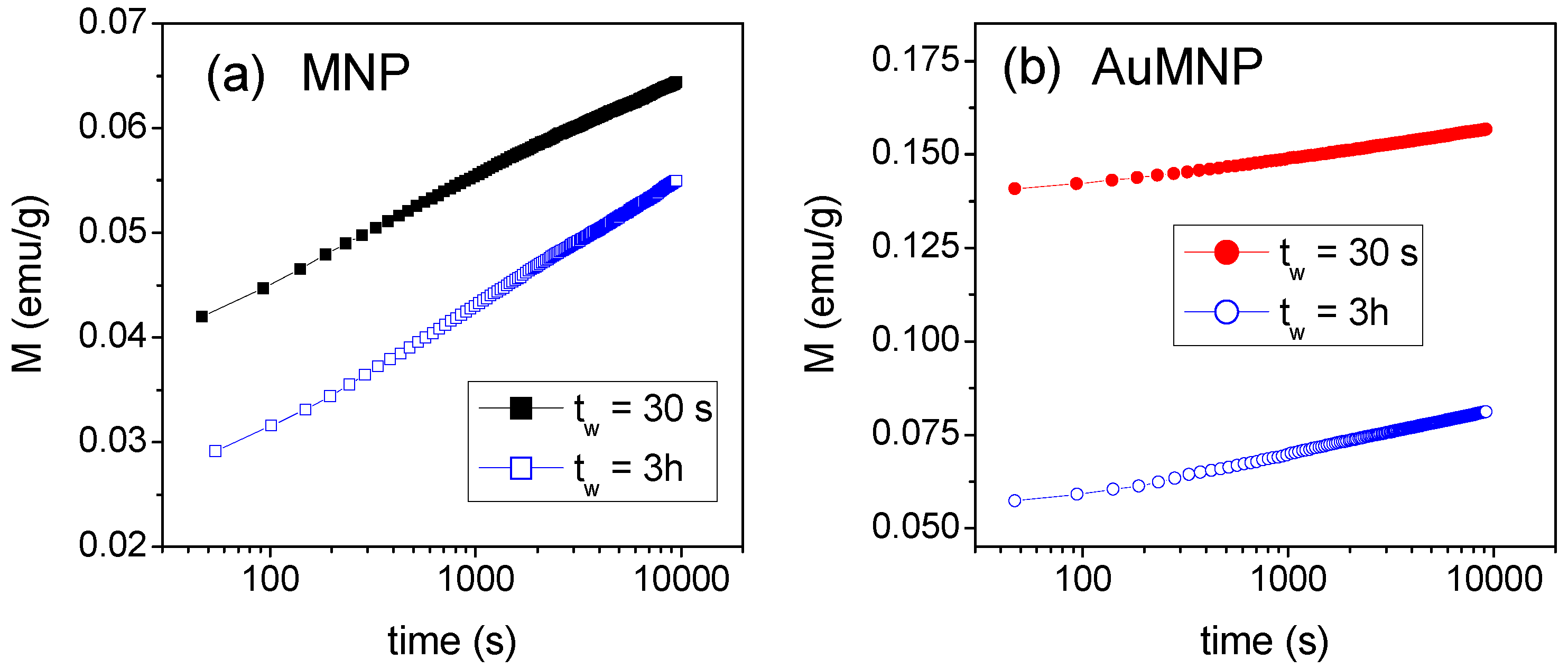
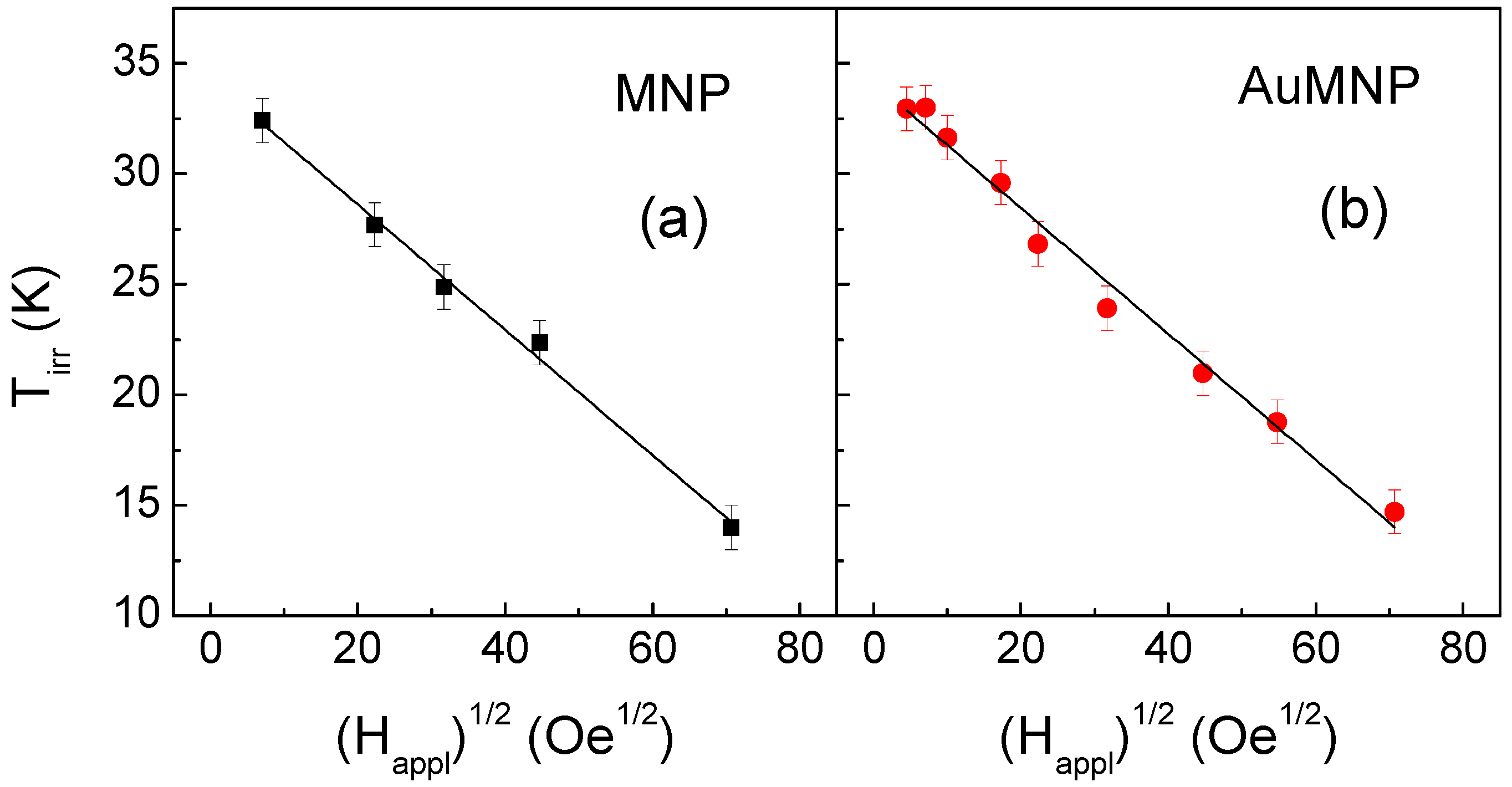
| Sample | MS (emu/g) ±1% | HC (Oe) ±1% | Hirr (Oe) ±2% | Keff (erg/cm3) ±2% | Hshift (Oe) | HC_DCD (Oe) 2% |
|---|---|---|---|---|---|---|
| MNP | 34.8 | 559 | 21300 | 1.82 × 106 | 38 ± 3 | 1300 |
| AuMNP | 19.0 | 221 | 6300 | 5.4 × 105 | 11 ± 2 | 618 |
© 2019 by the authors. Licensee MDPI, Basel, Switzerland. This article is an open access article distributed under the terms and conditions of the Creative Commons Attribution (CC BY) license (http://creativecommons.org/licenses/by/4.0/).
Share and Cite
Del Bianco, L.; Spizzo, F.; Barucca, G.; Marangoni, G.; Sgarbossa, P. Glassy Magnetic Behavior and Correlation Length in Nanogranular Fe-Oxide and Au/Fe-Oxide Samples. Materials 2019, 12, 3958. https://doi.org/10.3390/ma12233958
Del Bianco L, Spizzo F, Barucca G, Marangoni G, Sgarbossa P. Glassy Magnetic Behavior and Correlation Length in Nanogranular Fe-Oxide and Au/Fe-Oxide Samples. Materials. 2019; 12(23):3958. https://doi.org/10.3390/ma12233958
Chicago/Turabian StyleDel Bianco, L., F. Spizzo, G. Barucca, G. Marangoni, and P. Sgarbossa. 2019. "Glassy Magnetic Behavior and Correlation Length in Nanogranular Fe-Oxide and Au/Fe-Oxide Samples" Materials 12, no. 23: 3958. https://doi.org/10.3390/ma12233958
APA StyleDel Bianco, L., Spizzo, F., Barucca, G., Marangoni, G., & Sgarbossa, P. (2019). Glassy Magnetic Behavior and Correlation Length in Nanogranular Fe-Oxide and Au/Fe-Oxide Samples. Materials, 12(23), 3958. https://doi.org/10.3390/ma12233958








